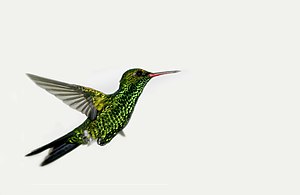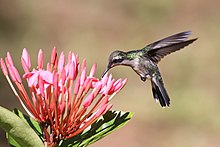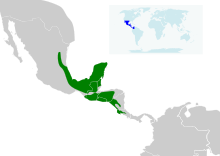Fork-tailed emerald hummingbird
| Fork-tailed emerald hummingbird | ||||||||||
|---|---|---|---|---|---|---|---|---|---|---|

Fork-tailed emerald hummingbird ♂ |
||||||||||
| Systematics | ||||||||||
|
||||||||||
| Scientific name | ||||||||||
| Chlorostilbon canivetii | ||||||||||
| ( Lesson, RP , 1832) |
The fork-tailed emerald hummingbird ( Chlorostilbon canivetii ) is a species of bird in the hummingbird family (Trochilidae). The species occurs in Mexico , Belize , Guatemala , El Salvador , Honduras , Nicaragua and Costa Rica . The IUCN assesses the population as Least Concern .
features
The fork-tailed emerald hummingbird reaches a body length of about 7.5 to 9 cm with a weight between about 2.1 and 2.8 g. The male has a straight red bill with a black tip on the upper bill. It has a moderately forked blue-black tail. The head and body are emerald green, glittering on the top of the head and on the underside. There are gray spots on the inner control springs . The female's tail is less forked. The outermost control springs are shorter than the nearest springs. A white line behind the eyes stands out from the green of the top of the head and the blackish ear covers. Neck and top are golden green, throat and underside pale gray. The inner control feathers are bluish green, the outer blackish with white spots. The two outermost control springs have a whitish central band. Male juveniles resemble the females in appearance, but the bluish black tail is slightly longer. The three inner control feathers are spotted green, the two outermost pale gray to whitish spotted. The underside is partly green. While they are developing their throat color, yellow-brown fringes can be seen on the face, neck and rump. In slightly older male young animals, the typical tail shape of adult specimens is formed, but the inner three tail feathers show light gray spots on the adult green and the outer ones are already completely blackish blue. The underside is then either completely green or they have a light gray throat.
Behavior and nutrition
From which plants he gets his nectar has not been researched. It is very likely that these are different small, short-tube flowers, as well as undergrowth that are pollinated in particular by insects and herbs and tendrils that are ignored by other hummingbird species. In Veracruz he probably uses the species Hamelia patens and Palicourea padifolia , which belong to the red family , the species Neobuxbaumia scoparia , which belongs to the cactus family, and the species Conostegia xalapensis, which belongs to the black- mouthed family . It also feeds on small arthropods . A female was seen catching insects sitting in her nest without feeding the chicks. As a trapliner, it flies regularly in rapid succession to very specific, scattered flowers in the lower and middle strata . He is often just above the ground and appears very nervous while he is feeding. He pumps his tail constantly and only briefly sucks on the various food sources. It probably exhibits this behavior because it is inferior to other hummingbird species in the same area.
Vocalizations
The singing of the fork-tailed emerald hummingbird consists of three to four light-sounding and waning psiiu ... psiiu ... psiiu tones, sometimes preceded by introductory tsippi ... tsii..tsii..tsii sounds. He sings constantly sitting on low-lying branches. Also dry rattling and chattering that z. B. what Tschut or Tschit sounds is part of his repertoire. During courtship, the male falls down and accompanies this with aggressive interaction. The dives go to just before the surface and at the lowest point the male gives off a dry crackling sound.
Reproduction
The breeding season of the nominate form is from February to May. On Cayos Cochinos in May a female was seen bringing in nest material. C. c. osberti is in a brood mood in El Salvador from December to February, C. c. salvini in Costa Rica at least from November to April, maybe even into June. The clean, goblet-shaped nest consists of light-colored fallen leaves and fibers and is lined with finer material. The outer radius is 47 mm, the inner radius 25 mm and 200 mm deep. The outside is decorated with chips and strips of bark. Usually the nest is in the undergrowth or herbaceous plants one to three meters above the ground. A nest was discovered only 75 cm above the ground. The clutch consists of two white eggs. There is no data on the breeding season, but hatching occurs exclusively by the female. The chicks hatch asynchronously, are black and have two brown stripes on their backs that start at wing level. The beak is yellow at the beginning. In general, there is two feedings per hour for the first two weeks, then three to four times an hour. The chicks fledge at 24 to 25 days.
Subspecies
So far, three subspecies are known:
- Chlorostilbon canivetii canivetii ( Lesson, RP , 1832) occurs from Tamaulipas via Belize, northern Guatemala and the Islas de la Bahía .
- Chlorostilbon canivetii osberti Gould , 1860 is distributed from southeast Chiapas to western Nicaragua. In this subspecies, the male has a shorter and less forked tail and more dull gray spots. The female also has a shorter and even less forked tail. The central band on the outer control springs is less noticeable than in the nominate form.
- Chlorostilbon canivetii salvini ( Cabanis & Heine , 1860) occurs in western Costa Rica. This subspecies is similar in appearance to the garden emerald hummingbird ( Chlorostilbon assimilis Lawrence , 1861). The upper bill is compared to C. c. osberti less brownish and more reddish. The central control feathers of the males have dense gray spots. Females and juveniles are easy to confuse with the blue-throated broad-billed hummingbird ( Cynanthus latirostris Swainson , 1827).
distribution and habitat
The fork-tailed emerald hummingbird prefers bushy forest landscapes, overgrown clearings and forest edges, as well as savannahs and cultivation areas. Usually these are found in dry to semi-humid areas. Reports of the nominate form exist at altitudes of sea level up to 1600 meters and up to 1900 meters for C. c. osberti . The subspecies C. c. salvini in Costa Rica is only found at altitudes below 800 meters and also breeds there in mangroves .
migration
Little is known about their migration behavior. Occasional reports of occurrence in Punta Gorda suggest seasonal movements, but it is present year-round in Veracruz, eastern Mexico. So it could be high altitude hikes or nomadic movement patterns.
Etymology and history of research
René Primevère Lesson described the fork-tailed emerald hummingbird under the name Ornismya canivetii . He had a type specimen from Emmanuel Jacques Canivet (1796–1849), another from Florent Prévost (1794–1870). He erroneously stated Brazil as the collection point. It was John Gould who introduced the new genus Chlorostilbon in 1853 . Only later was the Hispaniolas emerald hummingbird assigned to this genus. "Chlorostilbon" is made up of the Greek words "chlōros χλωρός " for "green" and "stilbōn στίλβων " for "shining". The Greeks gave Mercury the nickname Stilbōn, which is due to the verb "stilb" for "blink". The species name »canivetii« is dedicated to the man who made the type specimen available to Lesson. "Salvini" is a new name for Chlorostilbon caneveti Sclater, PL & Salvin , 1859 and thus refers to one of the two authors. "Osberi" was also awarded in honor of Osbert Salvin.
Adult fork-tailed emerald hummingbird illustrated by Jean-Gabriel Prêtre (1768–1849) as part of the first description
Chlorostilbon canivettii osberti illustrated by John Gould and Henry Constantine Richter
literature
- Josep del Hoyo , Nigel James Collar, Guy Maxwell Kirwan, Peter Boesman in Josep del Hoyo, Andrew Elliott, Jordi Sargatal, David Andrew Christie , Eduardo de Juana: Canivet's Emerald (Chlorostilbon canivetii) in Handbook of the Birds of the World Alive . Lynx Edicions, Barcelona.
- James A. Jobling: Helm Dictionary of Scientific Bird Names . Christopher Helm, London 2010, ISBN 978-1-4081-2501-4 .
- René Primevère Lesson: Histoire naturelle des colibris: suivie d'un supplément à l'Histoire naturelle des oiseaux-mouches: ouvrage orné de planches dessinées et gravées par les meilleurs artistes: et dédié AM le Baron Cuvier 66 plates (Prêtre, Antoine Germ ) . Arthus-Bertrand, Paris ( biodiversitylibrary.org - 1830-1832).
- Jean Louis Cabanis, Ferdinand Heine junior: Museum Heineanum Directory of the ornithological collection of Oberamtmann Ferdinand Heine on Gut St. Burchard in front of Halberstatdt. With critical comments and a description of the new species, systematically edited by Jean Cabanis, first custodian of the Royal Zoological Collection in Berlin and Ferdinand Heine, Stud. Philos. Volume 3 . R. Frantz, Halberstadt 1860 ( biodiversitylibrary.org ).
- John Gould: A monograph of the Trochilidæ, or family of humming-birds . tape 5 , delivery 5. Taylor and Francis, London 1853 ( biodiversitylibrary.org ).
- John Gould: Description of Twenty-two new Species of Humming Birds . In: Proceedings of the Zoological Society of London . tape 28 , no. 2 , 1860, p. 304-312 ( biodiversitylibrary.org ).
- Frederick Herschel Waterhouse: The dates of publication of some of the zoological works of the late John Gould, FRS RH Porter, London 1885 ( biodiversitylibrary.org ).
- Edward Clive Dickinson, Leslie K. Overstreet, Robert Jack Dowsett, Murray Duncan Bruce: Priority! The Dating of Scientific Names in Ornithology . Aves Press Limited, Northampton 2012, ISBN 978-0-9568611-1-5 .
- Philip Lutley Sclater, Osbert Salvin: On the Ornithology of Central America Part II . In: The Ibis . tape 1 , no. 2 , 1859, p. 117-138 ( biodiversitylibrary.org ).
Web links
- Chlorostilbon canivetii inthe IUCN Red List of Threatened Species 2018.1. Listed by: BirdLife International, 2016. Retrieved November 16, 2018.
- BirdLife International: Species Factsheet - Canivet's Emerald ( Chlorostilbon canivetii ) . Retrieved November 12, 2018.
- Videos, photos and sound recordings for Canivet's Emerald (Chlorostilbon canivetii) in the Internet Bird Collection
- Fork-tailed emerald hummingbird ( Chlorostilbon canivetii ) at Avibase; accessed on November 16, 2018.
- Chlorostilbon canivetii in the Integrated Taxonomic Information System (ITIS). Retrieved on 2018-11-16.
- xeno-canto: Sound recordings - Canivet's Emerald ( Chlorostilbon canivetii )
- Fork-tailed emerald hummingbird (Chlorostilbon canivetii) in the Encyclopedia of Life . Retrieved November 16, 2018.
Individual evidence
- ↑ a b c d e f g h Josep del Hoyo u. a.
- ^ IOC World Bird List Hummingbirds
- ↑ a b c René Primevère Lesson, pp. 174–178, plates 37 & 38.
- ^ A b John Gould (1860), p. 309.
- ↑ a b Jean Louis Cabanis u. a. (1860), p. 48.
- ^ John Gould, plate 355 plus text
- ↑ James A. Jobling, p. 103.
- ^ Philip Lutley Sclater et al. a. (1859), p. 130.
Remarks
- ↑ For the publication history of the work, see Edward Clive Dickinson u. a. P. 118f. The work appeared in 13 deliveries from 1830 to 1832.
- ↑ According to Frederick Herschel Waterhouse p. 47, Plate 355 appeared as part of Delivery 5 from 1853. Here Gould assigned the Chlorostilbon prasinus , a synonym for the blue-tailed emerald hummingbird ( Chlorostilbon mellisugus ( Linnaeus , 1758)) to the genus.




